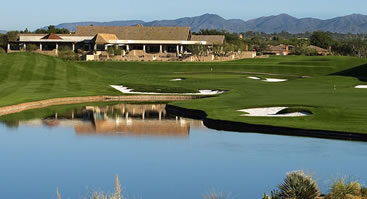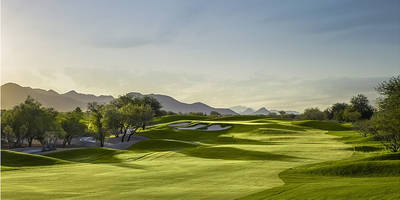
TPC Scottsdale Stadium, 18th hole
photo courtesy TPC Scottsdale
by Bradley S. Klein
Don’t let the guys at PGA Tour
headquarters get in the way of the big story at
this
week’s Waste Management Phoenix Open.
The real news out of TPC Scottsdale is that
players
were greeted by a totally revamped course.
They
can throw out their yardage books and learn the
place anew. It might look the same on TV, but in
person, the facility north of Phoenix that’s
hosting more than half a million spectators this
week
is a very different golf course than the one that
made its Tour debut in 1987.
OK, let’s get one thing out of the way.
The corporate Pollyannas in starched whites who
run
big-time golf out of Ponte Vedra Beach, Fla.,
have
put the kibosh on spectator-player interaction at
the
raucous par-3 16th hole by prohibiting Tour
players
from throwing objects into the stands. That
means
no more flying footballs, hats and soccer balls –
and
presumably fewer drunks falling out of the
stands.
But a curious thing is that along the way,
Tour
officials have allowed tournament organizers –
the
Phoenix Thunderbirds, in collaboration with
Waste
Management, Inc. – to expand seating at this
stadium-like hole. A third tier along the north
side of
the makeshift stands will now sell for a
premium,
enhancing total seating capacity by about 1,500
to
19,000 people. So while the Tour is squishing the
players’ spontaneity, it’s also
enhancing its own bottom line. Such is the
nature of
the golf business today.
TPC Scottsdale’s Stadium Course, a 30-
year old design by Jay Morrish and Tom
Weiskopf,
has always been one of those desert hybrids –
scrubby, arid ground on the periphery and lush,
heavily maintained turf and trees along fairway
corridors. The course was due for an overhaul to
update the irrigation system, rebuild bunkers
that
had been compromised, clean up lines and get
some
of the cart paths out of line and sight. Weiskopf
did
the re-design work and it turned out great.
Additional yardage, always desirable on the
PGA
Tour these days, was out of the question on a
site so
heavily bordered by hotel, commercial space
and
land designated for the Central Arizona Project
Canal. The latter structure is located right behind
the
18th tee and prevents the par-4 finishing hole
from
being stretched beyond 442 yards.
That’s OK. To make up for the inability to
move the tee back, the notorious carry down the
left
side (over water the entire way) was made
more
daunting than ever by adding a wacky-looking,
four-
row, Church Pews bunker at the far end.
Clearing
this sacrilegious hazard now requires a launch of
339
yards – up from 319 yards. The old hazard was
a
simple and deep bunker, and frankly, the new
hazard
looks idiotic. But it will work to keep all but the
boldest (or dumbest) players from trying to take
the
short cut.

|
No. 14 on TPC
Scottsdale's Stadium Course
(photo courtesy TPC Scottsdale)
|
Actually, the Church Pews on the 18th,
modeled
after the original Church Pews bunker between
the
third and fourth holes at Oakmont (Pa,) Country
Club, previously appeared at the TPC
Scottsdale’s short, drivable par-4 17th.
However, that bunker was so ill-positioned (way
left
and short) that it never came into play or view.
Now
on the 18th, it is conspicuous and, if truth be
told,
the only sore site on an otherwise stellar
renovation.
The greens that shrank have been
recaptured to
their full extent. The area around the hole
location
on the back-left peninsula on that infamous par-
4
17th hole is much roomier than it was in recent
years. A terribly awkward, banana-shaped green
on
the par-5 third hole has been abandoned and
replaced with a more accessible putting surface
and
moved further to the left, though not without its
own
steep bank that will surely prove controversial.
A hole-by-hole recitation is unnecessary.
Suffice
it to say that with gleaming new white bunkers
replacing the old, tired-looking brownish ones,
TPC
Scottsdale’s Stadium Course shines. Several
bunkers have been shifted to figure more
prominently into play from the back tees,
making
accuracy off the tee imperative. Pushing cart
paths
away from fairways in the landing areas and
around
greens makes the whole place look more like a
golf
course and less like a go-cart track.
It helps, too, that the TifEagle
Bermudagrass
surfaces on the newly rebuilt greens grew in
smoother and with less grain than the older
putting
surfaces. The course closed for six months in
mid-
2014 for renovation and didn’t reopen until
the overseeded rye grass was in place, dense
and
lush. Playing surfaces on the Stadium Course
have a
depth and consistency that are uncommon for a
desert tournament course as heavily played as
this
one.